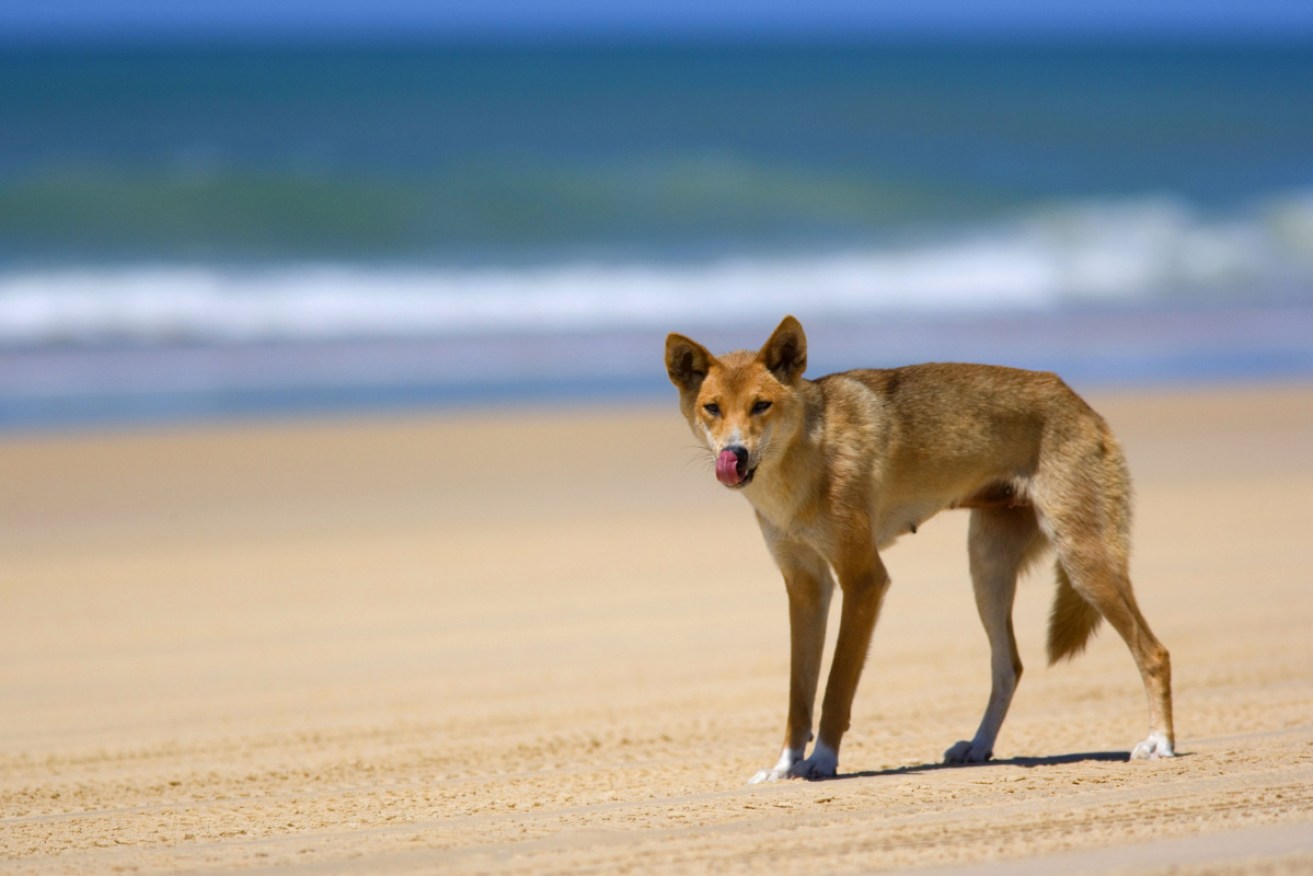Dingoes ‘hunting’ children on Fraser Island, incident reports reveal

A man has been bitten on the leg in the latest attack by a dingo on K'gari. Photo: AAP
Dingoes using “hunting tactics” towards children are responsible for frightening encounters reported to rangers on Queensland’s popular Fraser Island.
Details from official incident reports from 2017-2018, obtained by The New Daily, reveal how the wild dogs snatch, lunge at or circle children, often targeting unsupervised kids.
In one case a dingo grabbed a young boy by his T-shirt while he was playing on the beach and attempted to “drag him off” while the parents were only two metres away.
In another, a ranger watching a dingo saw it “gallop” to within 50 centimetres of a girl digging in the sand, stalk and circle the child and her mother and then lunge at her older brother.
Similar reports in which the native dogs targeted kids, even when adults were present, included:
- A dingo approaching a parent and daughter in the surf wash in an “aggressive manner” and prowling around them at close range “looking for a way to get to my daughter”
- A dingo circling a family of five on the water’s edge for about five minutes, occasionally lunging at the children
- A dingo making a “beeline” for a young girl while her parents were 30 metres away. A ranger gave chase and intervened
- Unconfirmed witness accounts of a dingo dragging a small child along the beach by its life jacket
- A dingo that “got up and ran straight for the children” swimming in a lagoon 100 metres away. The kids sought safety in a car and the dingo ran up the beach to another group of swimmers with children. It was later spotted with a dead wallaby
- And a dingo using a “hunting tactic” to run at two girls who were within three metres of their father on the beach.
There was also a disturbing instance of a family with two little children “squatting down next to a dingo, patting it”.
Filing a negative dingo encounter with the Queensland Parks and Wildlife Service is voluntary.
The Queensland government has ordered another review of dingo management on the island after a toddler was grabbed from a sleeping family’s camper trailer and dragged up the beach by his head over the Easter break.
It followed an attack on a six-year-old boy in January and nine-year-old boy and his mother in February.
On Thursday Environment minister Leanne Enoch announced new measures including higher penalties for feeding dingoes, new fenced camping areas and a new Indigenous ranger position to educate the public.
Scientists say the main cause of negative dingo behaviour is people feeding or interacting with the animals and causing them to lose their fear of humans.

Dingoes on Fraser Island have been losing their fear of humans. Photo: AAP
Visitors to the island – also known by its indigenous name K’gari – are warned to keep their distance and not feed, pat or interact with dingoes, which are considered a unique species.
On-the-spot fines will be increased to a minimum of $2088 and maximum $10,444 for feeding dingoes or not keeping food safe to taken to court.
Between 2007 and 2019 a total of 281 people were fined under sections 118 and 119 of the Recreation Areas Management Act 2006 and six people have been prosecuted in the courts since 2010.
The number of fines dished out varied from as low as three fines in 2003 from a peak of 51 in 2008. In 2018 only eight people were fined.
A spokesperson for the Department of Environment said rangers had “zero tolerance” for people feeding dingoes.
“Rangers know that behaviour shown by the dingoes involved in the incident over Easter were likely a result of them being habituated with humans, and have learnt to associate humans with food from either being fed by people, or from eating food that has not been locked up at campsites,” the spokesman said.
Researchers who have crunched the data and observed the animals say encounters with dingoes rarely result in serious injury, even when vulnerable children are involved.
A study of 160 of the “most serious” incidents between 2001 and 2015 found there was no increasing trend over the years and most occurred from March to April, which was breeding season, and in July, which is whelping time.
Of those, 23 per cent involved children and the worst happened when adults were not close enough to react quickly – more than five metres away, according to the study Human-Dingo Interactions on Fraser Island: An Analysis of Serious Incident Reports.
The death in 2001 of a nine-year-old boy, which sparked a major review of dingo management, happened when the children were “definitely unsupervised”, the study found.
University of Southern Queensland dingo expert Dr Benjamin Allen, who has helped review dingo management on the island, said dingoes were like many wild animals targeting smaller and weaker prey.

Visitors are warned not to get close to dingoes on Fraser Island. Photo: Instagram
Dr Allen said humans ignoring the warnings and feeding and interacting with dingoes was the “root cause” of the animals’ bold behaviours, but he said ramping up ranger patrols to enforce compliance was not necessarily the answer.
He said existing policies struck a balance between protecting the animals and people and ensuring both could enjoy the island.
Save Fraser Island Dingoes publicity officer Cheryl Bryant said the group had not received a response to its nine proposals to improve people’s safety and protect dingoes, which was submitted to the state government earlier this year.
Ms Bryant said the group suggested making it mandatory for children under 13 to camp in fenced areas, which would also limit visitor numbers.
The dingo advocates also called for signs warning about fines for leaving children unattended, more ranger patrols – especially at dawn and dusk when dingoes were active – and more visible contact information to report bad human behaviour.








